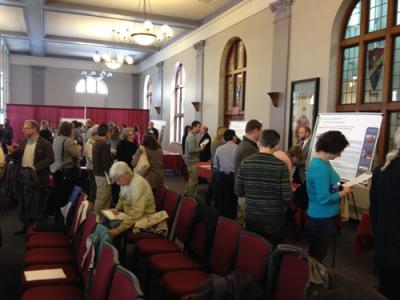Destination Erie Key Recommendations Unveiled
A look at the public meetings recently held and determing where to go from here.
When it comes to envisioning the future of Erie, a diverse array of institutions, organizations, and individuals are already hard at work. Destination Erie is an attempt to bring them together.
According to Project Manager Anna Frantz, "the goal has always been to break down silos between organizations working on issues that affect us." The project's three phases of development are nearing completion, and last week they unveiled a list of recommendations at public meetings across the county. Destination Erie's "regional vision" offers an opportunity for local citizens, business owners, nonprofits, and government officials to work together for the shared benefit of Northwestern Pennsylvania.
The project began in 2012, with approximately $1.8 million in federal funding from the department of Housing and Urban Development. Destination Erie is a large-scale planning initiative for the five-county region that surrounds Erie, with suggestions for sustainable development over the next twenty-five years. Those helming the plan started by establishing a baseline to assess the community's most crucial needs. Through a series of neighborhood workshops in the summer, local people were invited to help revise and improve the ideas.
The current draft recommendations offer suggestions about how to improve our local economy, make our neighborhoods safer, cultivate civic engagement, and protect our environment. Now that the recommendations are complete, they'll seek out local businesses, institutions, and citizens to help implement the ideas.
That may sound like a lot to accomplish. And Destination Erie is still working to address funding sources and key partners as they compose their final timeline, which will be unveiled in early 2015.
Still, Frantz is optimistic that several short-term priorities can be implemented soon. When I asked for a practical example, Frantz suggested we could build "more regional systems using technology to better track the issue of blight and coding enforcement." This approach could help us reduce or retrofit the abandoned homes in our region, maintain safety standards, and monitor landlord/tenant disputes more actively.
At the community meeting I attended on Nov. 20, tables were set up to highlight the recommendations. Informative handouts were made available, as were suggestion sheets to allow us to respond to the proposals. Community representatives were also on-hand to explain and discuss the eight areas of focus: Economic Growth and Development, Vibrant and Safe Communities, Education and Training, Arts, Culture and Recreation, Environment, Community Health, Regional Collaboration and Leadership, and Land Use, Infrastructure and Transportation Networks.
There are pragmatic ideas, like improving broadband Internet access, encouraging local food production, and updating Erie's plan for development on the waterfront. Some suggestions aim to attract visitors – such as the creation of a cultural tourism plan to highlight our region's industrial and maritime history. Other proposed projects are more ambitious, like the formation of a Tri-State Alliance to identify economic opportunities in our region and establish entrepreneurial projects that will support the local workforce.
What unifies these ideas is their interconnectivity. For example, consider the proposed Green Infrastructure Matching Grant Program. By encouraging eco-friendly construction projects, it could address our architectural and environmental needs simultaneously – and possibly create some well-needed jobs in the process. It would make things look better too – trees would be planted, facades would be updated, and stormwater runoff would be kept to a minimum.
At the meeting, Eve Holberg of the planning firm Peter J. Smith and Company claimed that about 18,000 manufacturing jobs have been lost in our region over the past fifteen years. In short, that's a really depressing number. Accordingly, it's understandable that some of Destination Erie's recommendations have been met with skepticism in our community. As technology changes and jobs are outsourced, it's easy to become disillusioned with large-scale public planning projects and promises about prosperity.
Some of the Destination Erie events have been a bit quarrelsome. I attended one of their Neighborhood workshops last summer and, among the half-dozen folks at my table, there were lively debates about topics ranging from natural gas exploration to home-schooling. On some issues, we found common ground, and on some we didn't. But we were still able to hear each other. And when the time came to offer suggestions, I felt that Destination Erie heard us as well.
Last week, I saw those conversations reflected in the proposals themselves. They clearly weren't the products of political polling or stuffy bureaucracies – they seemed borne out of healthy debates within our community. Once Destination Erie establishes a foundation for community partnerships, the heavy lifting will be up to us. Implementing the ideas will undoubtedly involve dialogue, compromise, and collaboration. As we begin to put the proposals into practice, I hope we can maintain the spirit of democracy on display at these meetings, warts and all.
Dan Schank can be contacted at DSchank@ErieReader.com.


.png)
